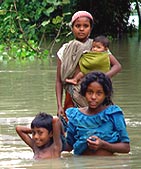|
|
|
||
| HOME | NEWS | SPECIALS | |||
| July 26, 2002
NEWSLINKS |
|
The Rediff Special/ G Vinayak  Hari Nath, a lower division clerk in Assam's Public Works Department, was reliving the nightmare of two years ago. In 2000, Nath and his family, who stay off National Highway 31C in Assam's Kamrup district, had to take shelter in a relief camp after surging waters of the Nona river entered their house and threatened to touch the roof. On July 22, 2002, the Nath family was back on the road after the Nona river, fed by incessant rains in the catchment areas in adjoining Bhutan, breached the embankment near their house and flooded the village. About 400 kilometres away, Balen Pegu and his family of six are sheltered in a relief camp in Dhemaji district, contemplating their future after the surging waters of the mighty Brahmaputra washed away their house just a week ago. It is the same elsewhere in the state. Reports say floods have affected at least a million people in 14 of the state's 23 districts, almost an encore from last year. Consider the dismal statistics: 21 of Assam's 23 districts routinely suffer from floods, while districts like Dhemaji and North Lakhimpur remain flooded for nearly three months, the number of people frequently affected is 3.6 million while the standing crop area damaged is over 200,000 hectares. In the current floods, the number of dwelling units damaged is over 200,000 and 18 lives have been lost. The total estimated damage to public and private property is Rs 18 billion. Yet, cold statistics never convey the misery that the people go through, and have been going through every year since 1950. Assam, perhaps the only state with a full-fledged Flood Control Department headed by a Cabinet minister, faces floods from the mighty Brahmaputra, one of Asia's biggest rivers, and its tributaries every year. Yet, little is done by way of preventive measures and even elementary steps like stocking food grains for the monsoon season is marked with indifference. This year, for instance, against the normal practice of building up a buffer stock of nearly two million tonnes of food grains in the region, the authorities have stored just about one million tonnes. In 1981, the Brahmaputra Board, whose purpose is to implement schemes to harness the mighty river, was set up. All that it has done in the last 21 years is prepare a master plan that envisages building two massive multi-purpose dams on the Dehang and Subansiri rivers, tributaries of the Brahmaputra, in Arunachal Pradesh and smaller dams on the other tributaries. At current estimates, the two mega-dams alone will cost a huge Rs 250 billion to build. The master plan has simply gathered dust. For 11 years, the Board was without a chairman until it was revived in 1995 with appointments to some key posts. And political rivalry between the neighbouring states of Assam, Arunachal Pradesh, and Manipur has prevented construction of the dams that could help in controlling the floods. Roads crisscrossing the northeast are most affected by the annual floods. The state government, which receives huge funds to repair the national highways, often diverts the money to other areas, thus leaving important national highways in a state of constant disrepair, hampering smooth communication. This means that the northeast, which imports essential commodities worth almost Rs 15 billion per annum from other parts of the country, is perpetually short of supplies. A major reason for the floods becoming an annual feature is directly linked to the massive deforestation, which is actively encouraged by the extremely powerful and influential timber lobby across the northeast. Timber from the northeast is among the most valuable and sought after in the country. Indiscriminate deforestation has led to massive amounts of topsoil coming loose in the rains. Thus, the soil, instead of soaking up the rainfall, flows down into the river and in turn causes the riverbeds of the Brahmaputra and its tributaries to rise. Engineers at the Flood Control Department, Assam, have estimated that nearly 27.3 billion tonnes of silt has accumulated in the Brahmaputra river between 1950 and 1997. The riverbed off Dibrugarh, in upper Assam, has risen by as much as three metres! What, then, is the solution? Assam has tried several schemes over the years but most of them have been ad hoc. For instance, the network of embankments and dykes spread all over the state can partially take care of the rising waters. The problem is that nearly 70 per cent of the state's embankments, running into a length of some 4,448 kilometres, have lost their capacity to prevent floods and strengthening the embankments would require a massive inflow of funds. "Most of the embankments in the state have outlived their utility since all of them were built in the 1960s," said Captain P K Das, secretary, Flood Control Department. "To strengthen them would require a lot of money, which the state government does not have at the moment." Adds another official in the Flood Control Department, "Thanks to the Centre's enthusiasm in deducting interest on the central loan assistance meant for us, we end up getting measly sums every year." The figures speak for themselves. Between 1974 and 1996, the Centre sanctioned Rs 3.41 billion as central loan assistance, but after deducting interest at source, Assam got a mere Rs 1.98 billion! "We cannot control the floods with our own resources, which are already in bad shape. Most of the funds meant for rural development are being utilised for ad hoc flood damage repairs. And the Centre continues to say that it has no funds to implement the Brahmaputra Board projects despite having declared floods as a national problem," the official complained. As of now, there just does not appear to be any immediate solution in sight for the perennial problem and the havoc wreaked by the floods, save for responding to them. Thus, every year, we see the Indian Army, reviled and much-resented in the rural areas in normal times, becomes the saviour of the people, launching massive rescue missions with several dozen boats and thousands of troops involved to ferry people from marooned places to safety; the civil authorities worry about the inevitable outbreak of epidemics; food shortage becomes acute as most of the standing crop gets destroyed; and several stretches of National Highways 31, 37, and 52, which also link the rest of the northeastern states to Assam, get washed away. Then, after the waters recede, marginal farmers like Balen Pegu in the worst affected districts such as Dhemaji ponder their plight. In the post-monsoon period, around the end of September, all that Pegu will see of his paddy field is that it under knee-deep slush and sand. Pegu and his family of six would have barely survived the floods and would have to struggle to survive the flood-induced poverty. Pegu, a small-time farmer who ekes out his living by cultivating a small patch of land, will wonder about what he could do for a living and for his family in the coming months. The receding waters bring their own set of problems. With miles and miles of roads having disappeared and several bridges washed away, no vehicles can reach Pegu's village. When the area is flooded, as it is now, at least the boats run by the Army can bring in the essential items. Now even that does not happen. "I do not know where my next meal is going to come from," laments Pegu. And he is not alone. Several thousand families in Dhemaji and the adjoining Lakhimpur district live on the verge of starvation. As the local legislator in the state assembly, Dilip Saikia, observes, "Every year the floods ruin the people in more ways than one. While the immediate danger is always of water-borne diseases spreading to a vast section of the population in the absence of safe drinking water, the long-term problem is starvation deaths since no land in the area is suitable for cultivation in the post-monsoon season." The Brahmaputra is known as the Borha Luit or the Old Red River or the Bor Noi, meaning the Big River, but many in Assam prefer the nickname, the 'River of Sorrow'. Design: Rajesh Karkera
|
|
| Tell us what you think of this special report | |
|
HOME |
NEWS |
CRICKET |
MONEY |
SPORTS |
MOVIES |
CHAT |
BROADBAND |
TRAVEL ASTROLOGY | NEWSLINKS | BOOK SHOP | MUSIC SHOP | GIFT SHOP | HOTEL BOOKINGS AIR/RAIL | WEDDING | ROMANCE | WEATHER | WOMEN | E-CARDS | SEARCH HOMEPAGES | FREE MESSENGER | FREE EMAIL | CONTESTS | FEEDBACK |
|